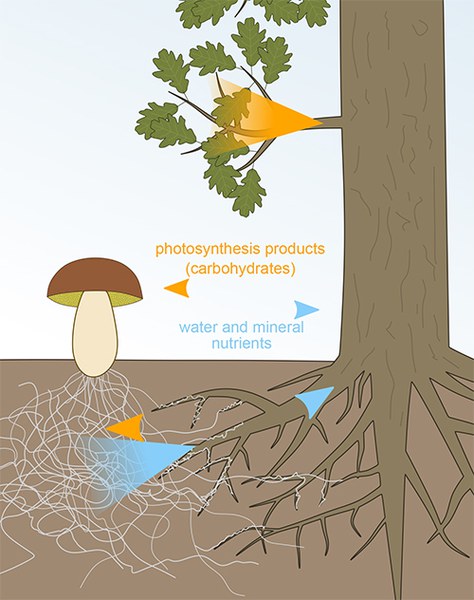What do you think about when you hear the word ‘fungi’? Perhaps your favorite pizza topping, or maybe a cartoon toadstool, or even an afternoon of foraging in the forest. But what about an underground network that shares resources? Well, if that’s the case, then we’re talking about mycorrhizae.
Mycorrhizae, according to Merriam-Webster, is “the symbiotic association of the mycelium of a fungus with the roots of a seed plant.” Whew, that’s a lot to unpack. Let’s start at the beginning. Mycorrhizae, the plural form of mycorrhiza, comes from the Greek for ‘fungus’ and ‘root.’ Let’s take it a step further—mycelium are the filaments of a fungus, essentially, its version of roots. And seed plants are those trees, flowers, grasses, and other plants that produce seeds. Put it all together, and you’ve got a mutually-beneficial relationship between fungus and plants that's happening underground.
There are two main classes of mycorrhizae. Ectomycorrhizae—also known as sheathing mycorrhizae—cover the ends of a plant’s young roots, almost forming a sheath around the roots. They belong to a fungal class that commonly produces mushrooms as their fruit, so if you see mushrooms in the root zone of a tree, there’s a good chance there’s some ectomycorrhizae underfoot! Many evergreen trees and shrubs have relationships with ectomycorrhizae fungi. The ectomycorrhizae help with the absorption of phosphate, ammonium, and zinc, all nutrients that help a plant grow. The second class of mycorrhizae is endomycorrhizae, which invades plant’s roots and develops entirely within the plant. Don’t forget though, it’s still a mutually-beneficial relationship!
The majority of plants are colonized by endomycorrhizae, while ectomycorrhizae almost completely build relationships with woody plant species. Some plants even have both classes of mycorrhizae. Mycorrhizal fungi are everywhere in the soil!
While mycorrhizal fungi are pretty amazing, they do have threats to their survival. Chemical sprays and fertilizers can kill them, and tilling the soil tears up these networks as well. To help keep mycorrhizal fungi communities strong in your yard (and help the plants in your yard at the same time), you’ll want to: 1. keep the fertilizer out and 2. not till your soil.
The world of fungi is fascinating and full of interesting discoveries. Join the Land Trust for our January 25, 2023 Nature Night on Fungi of the Forest with Ariel Cowan to learn even more.
Sources:
- Mycorrhizae, Wisconsin Horticulture Division of Extension
- Hidden Partners: Mycorrhizal Fungi and Plants, The New York Botanical Garden
- Mycorrhizae, Martin Jurgensen, Dana Richter, Carl C. Trettin, Mary Davis
- Mycorrhizae, University of Nevada, Reno Cooperative Extension
Learn more:


